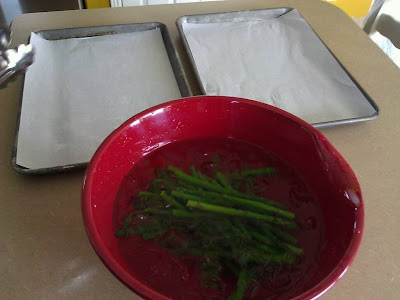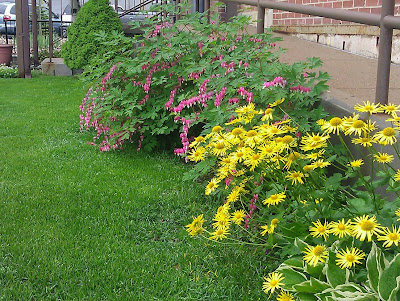Freezing Fresh Asparagus
We recently decided to make a trip around the corner (Not literally, but darn near...) to our local U-pick-it farm, Day Farms in West Layton, UT to pick ourselves a few pounds of fresh asparagus to put up for this year.
Of course we always eat some of it fresh in the spring as well, but asparagus is one of those very short season crops that we really enjoy having at other times of the year. We can either pay the price, both in dollars and in "food miles", to get it all year long, or we can take a little bit of time when that crop is in season here to not only enjoy it fresh but put some up for later. So that's what that afternoon was about.
After the trip to the farm, where we picked six pounds of asparagus - which cost us a mere $9.00 by the way - we brought it home and immediately soaked it in cool water to let any dirt fall from it and to make sure the spears stayed fully hydrated and crisp while we prepped for freezing them.
The first thing we did was to prep a few pound at a time by trimming off the ends of the shoots. After that we needed to blanch the asparagus in a boiling water bath.
NOTE: If your processing quite a few pounds of asparagus, or any other food for that matter, it can be tempting to try to use a big pot and do a lot at one time. Don't. You'll cool the water off too much and won't get a good blanch. Also, it's easier to work with smaller batches, a pound or two max, at a time.
Blanch your spears of asparagus for between two and four minutes depending on the thickness; ours were all a medium size so we went for two minutes.
After the blanch, you'll need to immediately place them into a cold ice bath to shock them and stop the cooking immediately. Leave them in here for a few minutes until they are completely cool. Usually the time between batches is perfect.
This next step isn't necessarily "in the book" but it's one we took anyway. We laid the spears out on a wire rack to let then drop dry a little. Isn't the color Amazing?! The reason we took this step was because we will be freezing them and excess water will only add ice and too much ice can cause damage to the end product.
After they've dried a bit, we laid them out on a parchment lined cookie sheet in one layer and placed them in the freezer. We've found that it's better to freeze our vegetables this way rather than to bag them first and then freeze because it sort of coats the product in an individual ice shield and allows you to remove what you need later one at a time rather than having one big lump of whatever it is.
After the spears are just frozen through, we separated them out into individual spears and vac-packed them in our new kitchen tool for this year. (We allow ourselves one handy time saver or food prep item per year generally.) We packed them in to groups of 30/pk to allow for five so per family member per meal and a possibility of a couple of left overs for lunch for me the next day.
We packed up 8 or 9 bags of these and will probably try for some more this weekend. Of course, there's other things to do with asparagus too... like pickles and soup...
Stay tuned!
P~
Of course we always eat some of it fresh in the spring as well, but asparagus is one of those very short season crops that we really enjoy having at other times of the year. We can either pay the price, both in dollars and in "food miles", to get it all year long, or we can take a little bit of time when that crop is in season here to not only enjoy it fresh but put some up for later. So that's what that afternoon was about.
After the trip to the farm, where we picked six pounds of asparagus - which cost us a mere $9.00 by the way - we brought it home and immediately soaked it in cool water to let any dirt fall from it and to make sure the spears stayed fully hydrated and crisp while we prepped for freezing them.
The first thing we did was to prep a few pound at a time by trimming off the ends of the shoots. After that we needed to blanch the asparagus in a boiling water bath.
NOTE: If your processing quite a few pounds of asparagus, or any other food for that matter, it can be tempting to try to use a big pot and do a lot at one time. Don't. You'll cool the water off too much and won't get a good blanch. Also, it's easier to work with smaller batches, a pound or two max, at a time.
Blanch your spears of asparagus for between two and four minutes depending on the thickness; ours were all a medium size so we went for two minutes.
After the blanch, you'll need to immediately place them into a cold ice bath to shock them and stop the cooking immediately. Leave them in here for a few minutes until they are completely cool. Usually the time between batches is perfect.
This next step isn't necessarily "in the book" but it's one we took anyway. We laid the spears out on a wire rack to let then drop dry a little. Isn't the color Amazing?! The reason we took this step was because we will be freezing them and excess water will only add ice and too much ice can cause damage to the end product.
After they've dried a bit, we laid them out on a parchment lined cookie sheet in one layer and placed them in the freezer. We've found that it's better to freeze our vegetables this way rather than to bag them first and then freeze because it sort of coats the product in an individual ice shield and allows you to remove what you need later one at a time rather than having one big lump of whatever it is.
After the spears are just frozen through, we separated them out into individual spears and vac-packed them in our new kitchen tool for this year. (We allow ourselves one handy time saver or food prep item per year generally.) We packed them in to groups of 30/pk to allow for five so per family member per meal and a possibility of a couple of left overs for lunch for me the next day.
We packed up 8 or 9 bags of these and will probably try for some more this weekend. Of course, there's other things to do with asparagus too... like pickles and soup...
Stay tuned!
P~

























